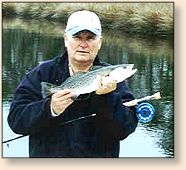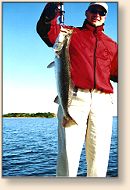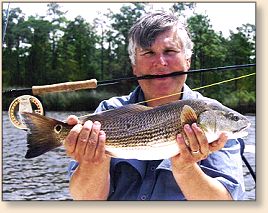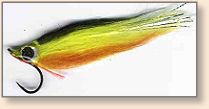
February and March were such phenomenal months.
We fished those creeks just south and east of
the big bridge and the trout just kept getting
hooked up. I wondered how there could be any
water left in the river. Between the stripers
and the specs, limiting out every day was just
too good to be true, especially on fly. My
friend Greg said that eventually they would move
and we would know this soon enough.
It was on a bright sunny day in early May that
this revelation became evident. To me the water
looked Cobalt Blue, but I could have my hues mixed
up. The water was kind of dark blue but it was
bright at the same time. It was a picture perfect
sky with a few high white clouds.

We fished a creek just south of Upper Broad Creek
and we didn't get a hit in three hours. "Well",
I thought, "they were here yesterday and every day
before. Could we have fished them out?" Frantically,
with the prospects of getting skunked, I phoned Greg.
"Hey man, where the hell did all the trout go," I
remarked. "Try two creeks down", he replied. So
the salinity in the river changed that much, overnight
almost. The early spring rains in Raleigh and Durham
finally had reached our part of the river. The amount
of fresh water was good and bad. Good in the sense
that it flushed the creeks and started a natural
cleansing process. Bad because the fresh water
depletes the level of oxygen in the water and forces
the fish towards the sound, called "staging."
North Carolina, under the leadership of Governor
Easley started on the Coastal Habitat Protection
Plan (CHPP) in 1997. CHPP is responsible for about
2.5 million acres of coastal and marine waters that
are prime spawning and nursery grounds for most of
the State's important fish species and many that
migrate along the East Coast, including Tarpon.
The underwater garden in our creeks is vital to the
coastal ecosystem. Aquatic plants are natural
recyclers. They take nutrients from the sediment
and release them into the water when they die.
Decomposed plant matter and its associated bacteria
are actually more important food for fish that the
living plant leaves. The decomposed plants are food
for shrimp, bacteria and fungi, which in turn are
eaten by larger animals. Geese and many kinds of
ducks depend on the living leaves, roots and other
parts of the plants.
More than 40 different species of fish and
invertebrates have been collected from grass beds,
which are busy nurseries for young croaker, spot,
mullet, red drum, flounder, blue crabs and pink
shrimp. Grass shrimp, spotted sea trout (specs)
and gray trout (weakfish) spawn in the grass, and
bay scallops need grass meadows to survive. The
plants and oysters cleanse the water and filter
oxygen back into the water. They also help reduce
erosion by sheltering the land from waves. High
salinity also means that the water holds more oxygen,
important for game fish. As the salinity drops the
fish move towards areas of high salinity to maintain
their comfort level.
Well, Greg was right, the fish were moving down the
Neuse near Marker 11. Around Slocum and Hancock
Creek, the bite was back on. We fished creeks
on both sides of the river just above the Minnesott
Ferry Terminal. The speckled trout were now
staging about half way between New Bern and Oriental.
The other surprise was catching redfish or puppy drum.
We caught a few here and there but didn't see any
schools. The water inside Slocum Creek was clean
and reminded me a lot of fishing the Lagoon back
in Florida.

We were using Fire Tiger and Junior flies that resembled
some L&S Bait Patterns. The flies work well when fished
as subsurface flies with a steady retrieve. One of the
local guides and I tie these "big-eye bait fish flies"
and they work 95% of the time.

Actually I got the pattern ideas from Nicky Adams and
Fred, both native New Bernians. These flies are
extremely effective when fished with clear intermediate
line. I like the Cortland 555 Little Tunny Intermediate
Rocket Taper (Camo), but Orvis Wonderline Advantage and
SA Ultra 4 work well too.
Eight weight rods seem to provide the best action, although
I prefer my T3 6-weight Saltwater rod. One other fly
that is really effective is a DS Junior SS big eye fly.
Worked slowly this fly looks and acts like a fingerling
mullet. It is especially good in backwater creeks that
have a tannic coloration to the bottom.

Paul Olsen and his son from Oriental were out with me
in one of these creeks. We were having a really
terrific morning. His son hooked up 2 trout and
then came a loud crack, and unmistakable sound of
graphite shattering. Paul had broken his new fly
rod. So he switched to an 8-weight Old Florida
and landed his first speckled trout on fly rod after
having his first fly-casting lesson only the week
before.
At the end of May the river gets crowded. River Fever
is on the rise as schools let out for the summer,
families start thinking about vacation and executives
start calling in sick only to be seen in their
favorite creeks. The regulars like Greg, Nicky,
Fred, Chip and Dave are always on the river, 3 or 4
times a week on average, 12 months a year. They grew
up on the Neuse and know every blade of grass and
every stump in its waters. They know instinctively
which species to fish and where they will be at any
given time of the year. It's great having them as
friends.
The summer season is tremendous fishing. As the
trout move towards the sound, the redfish, bluefish,
flounder and croaker become more abundant. As the
rains come in late spring the salinity becomes
freshwater and that brings large mouth bass, blue
gill, chain pickerel, pumpkin seed, cypress trout,
spot, rock and gar. Farther down the river the
first signs of summer approach with migrating red
drum (primarily nocturnal feeders) and tarpon start
to show up in time for the Rotary Club Tournament
on the Neuse in July. This year 15 tarpon were
taken and released, each weighing in at a little
over 100 pounds.
Please don't teach your trash to swim ~ Doug.
About Doug:
Capt. Doug Sinclair has relocated from New Smyrna Beach, Florida to
Grantsboro, NC. He specializes in fly-fishing and light tackle charters.
Doug charters the Coastal Carolina area of New Bern or Oriental.
Catch him on the web at
www.flyfishacademy.net or call him at (252) 745-3500.
|






